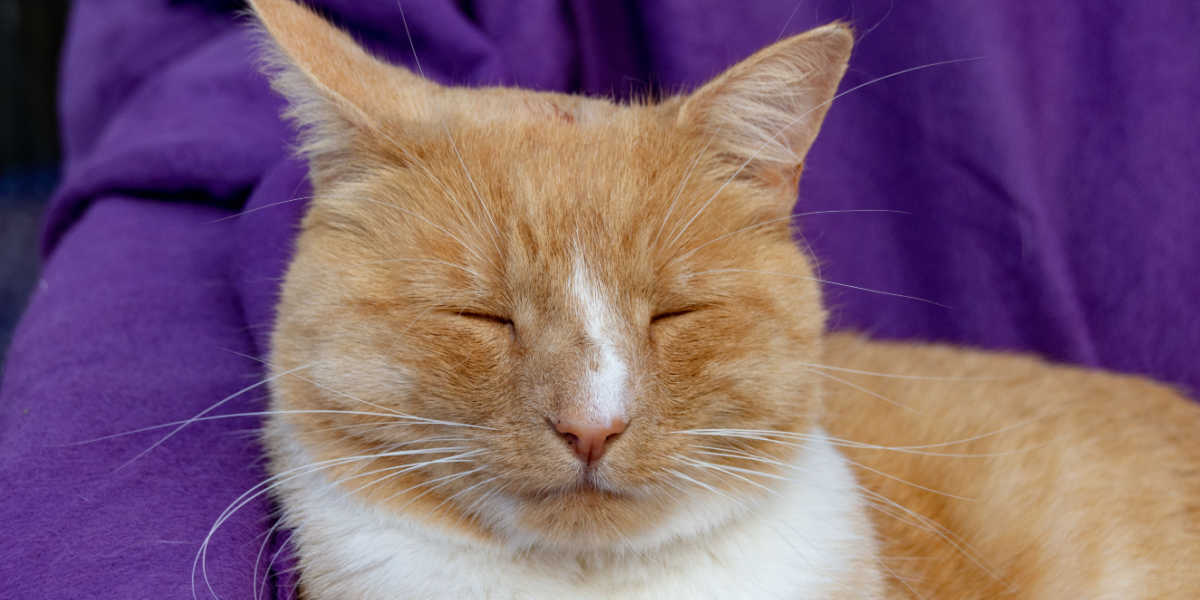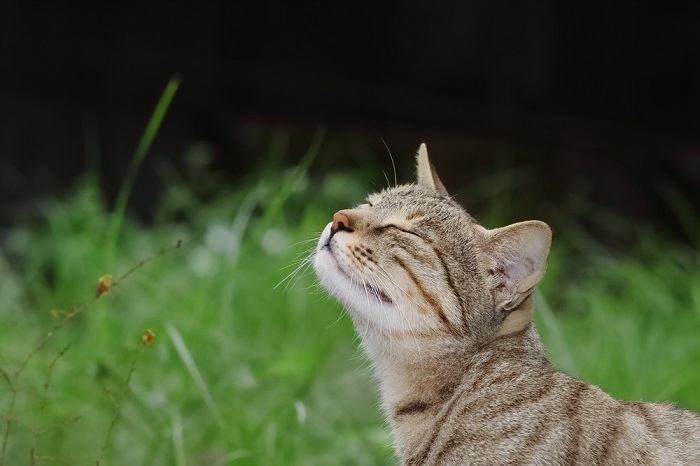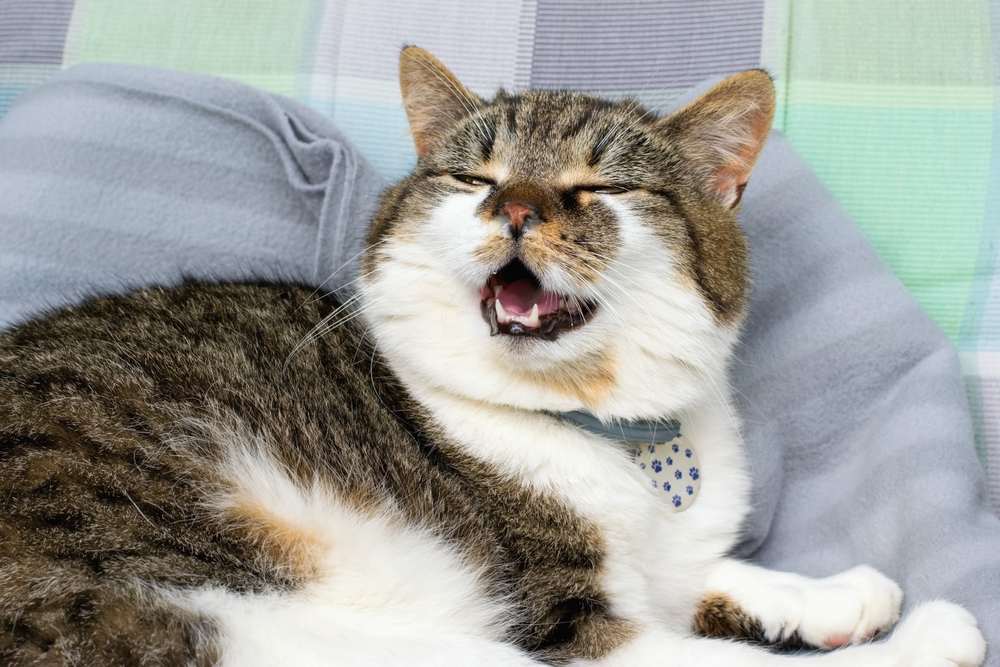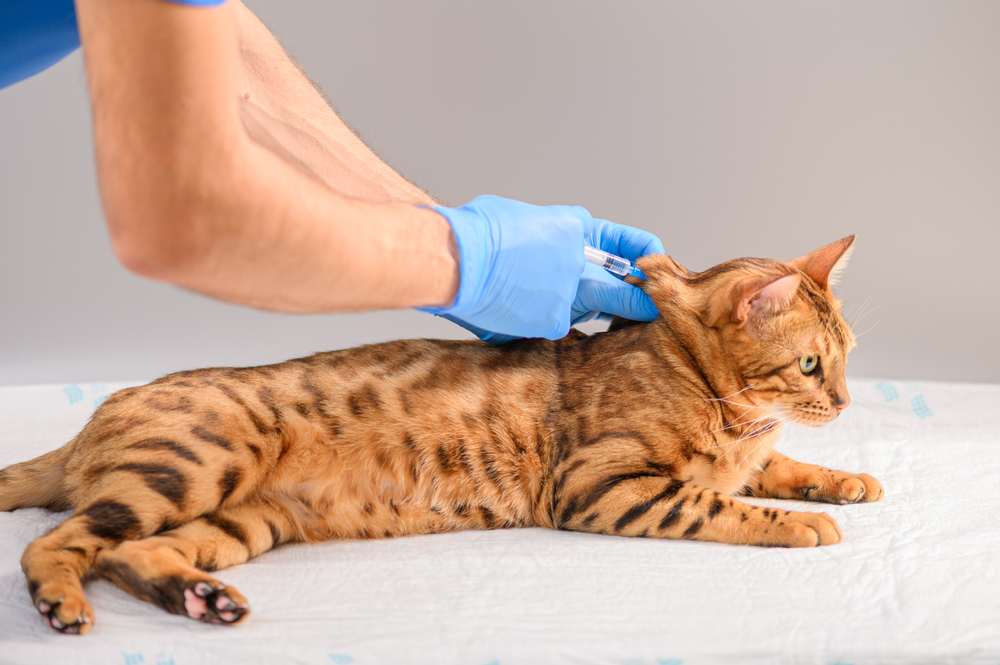
Kitties need their noses and powerful sense of smell to interact with their environments and for seeking out food. This makes swelling of the nose problematic in any cat. Swollen nose conditions can be split into what occurs internally and what occurs more externally. In this article you’ll learn about appearances in both cases, underlying causes, treatment approaches, and some frequently asked questions.
Also Read: Why Is My Cat’s Nose Dry and Cracked? Top 5 Reasons
Cat Swollen Nose: Is Swelling Inside or Outside?
Internal swelling of the nasal passages in cats is very common. This is the type of swelling that occurs with upper respiratory tract infections and allergies. There is usually no visible swelling on the outside of the nasal bridge and is just of the tissues inside the nose, sometimes extending to the sinuses.
Swelling on the outside of the nose or nasal bridge is fortunately less common but is far more visible, sometimes causing an asymmetric or puffy appearance to a kitty’s face. This appearance can be caused by trauma to the nose, but can be caused by serious infections and cancer as well.
A runny nose and sneezing can occur in both cases.
Possible Causes of Swollen Nose in a Cat

External swelling of the nose is often very visible, resulting in a asymmetric look to the face, and obvious puffiness
We’ll divide these causes into those that cause more internal swelling of the nasal passages and sinuses, versus visible external swelling of the nasal bridge.
Internal Swelling
Swelling within the nasal passages is called rhinitis. When the sinuses become involved too, it is termed rhinosinusitis. There can be several causes of rhinosinusitis.
1. Viral
This is the most common cause of rhinosinusitis in cats, typically caused by feline herpes virus (FHV) and feline calicivirus. These most often affect young kittens who still have immature immune systems and are then carried by the cat for life. Symptoms may reappear during times of stress or when the immune system is otherwise compromised and cannot keep the presence of the virus in check.
2. Inflammatory
Inflammatory rhinosinusitis is often the result of damage to the tissues and filtration systems of the nasal passages and sinuses from chronic viral infection by herpes or caliciviruses. The inflammation can remain and progress long after the levels of virus presence subside. One example is called lymphoplasmacytic rhinitis which is a less common but more severe form of chronic rhinosinusitis.
3. Bacterial Infection
Bacterial infections of the nasal passages can occur on their own, but more often occur secondary to the presence of viral infections. The inflammation viruses cause can allow bacteria to overgrow. Common bacteria involved include Bordetella bronchiseptica and Chlamydophila felis.
Also Read: Bacterial Infections In Cats: Causes, Symptoms, & Treatment
4. Fungal Infection
Fungal infections are less common in cats compared to viral and bacterial causes of upper respiratory infection but should always be a consideration. The most common fungal organisms seen in nasal cavity disease are Cryptococcus neoformans, Aspergillus, and Penicillium species.
5. Allergies
Allergic rhinitis can occur in cats both seasonally and year round. Seasonal allergies most often occur secondary to pollens while year-round allergens occur more secondary to indoor allergens like dust (including from cat litter) and molds.
6. Foreign Material
Occasionally, some piece of foreign material may make its way into the nasal passage. Examples have included blades of grass and other plant material, bits of food, and litter among others. Suspicion for a foreign object may be higher if nasal discharge is seen from only one nostril.
7. Cancer
Cancerous tumors can occur in the nasal passages, well out of view to be seen. While not exclusively the case, discharge from only one nostril may be seen. Bloody discharge from the nose may also be seen more often with cancer compared to infections. The most common cancers that occur in the nose include lymphoma and carcinoma, occurring about equally in cats.
Also Read: Cancer In Cats: Causes, Symptoms & Treatment
8. Nasal Polyps
Nasal polyps are small benign masses that can occur inside the nasal cavities of cats. They are not considered cancer, but can cause congestion, nasal discharge, sneezing, and secondary infections.
External Swelling
External swelling is characterized here as inflammation and swelling of the nasal bridge and/or other parts of the face of a cat. There are far fewer causes that contribute to this appearance, but they are unfortunately more serious in most cases.
1. Trauma
If your cat gets a swipe across the nose from a housemate or other cat, swelling can certainly occur since it is a wound that causes inflammation. But typically, the swelling is mild and you’ll be able to see the nail mark. Bite wounds caused by other cats can commonly cause swelling and abscesses on the face. This usually does not involve only the nasal bridge, but it can be involved along with other parts of the face.
Other causes of trauma to the face, especially impact trauma, can lead to generalized swelling, including the nasal bridge. Fractures to nasal and facial bones will cause very visible swelling and pain. Usually in these cases, trauma may be seen or suspected and swelling occurs very quickly.
2. Fungal Infection
The most common type of infection that will cause visible swelling of the nasal bridge is a fungal infection. Cryptococcus is the most common fungal organism that causes this, with others including Aspergillus felis, Sporothrix species, Histoplasma capsulatum, and Blastomyces dermatitidis.
3. Cancer
Other than fungal infections, the most common cause of a nasal bridge swelling and facial deformity in a cat is from a cancerous cause. As mentioned, carcinoma and lymphoma are the most common nasal cancers in cats, though carcinoma is more often the cause of facial deformities.
When to Call the Vet

Visible swelling on a cat’s face should warrant a trip to the veterinarian.
If your cat is doing a little sneezing occasionally, there may be no need to panic. After all, sneezing is a normal response to clear the nasal passages and we all sneeze occasionally. The odd sneeze may be from a little dust or another irritant.
But beyond occasional sneezing, here are some guidelines to follow when you should make a vet appointment as soon as possible.
- Visible swelling of the nasal bridge or other facial deformities: any visible swelling is always a serious concern, regardless of the cause and should be evaluated for the best treatment.
- Uncontrolled runs of sneezes: if your cat sneezes several times in a row and an event like that occurs more than once, this raises concern for something lodged in or blocking the nasal passage.
- Blood discharge from the nose: if this occurs after a heavy run of sneezes, it may be related to a bad infection and resultant swelling of internal tissues. However, this also raises the concern for the presence of a fungal or cancerous mass, especially if the discharge is only from one nostril instead of both.
- Thick white, green, or yellow discharge from the nose: this appearance is a reasonable way to differentiate the presence of a mild allergy or irritation with a bacterial or fungal infection. This usually indicates the need for medical therapy.
- Any trauma incident leading to wounds, visible swelling or behavioral changes: trauma may lead to immediate changes like swelling and pain that are obvious, but changes can also be delayed as well. Especially in cases of head trauma, delayed effects can be very severe and it is best for vet evaluation as soon as possible.
- Accompanying signs of decreased appetite, lethargy, or hiding behavior: Any time any kind of upper respiratory condition or visible swelling of the nose is accompanied by these types of changes, you can be more certain something is wrong. A cat’s ability to smell food may be affected, or they may be in pain.
Also Read: 11 Signs That You Need to Get Your Cat To the Emergency Room
Treating a Swollen Nose in a Cat
Following an initial exam, your vet will look to determine the best diagnostic steps to follow. During an exam, your vet may check for other signs of illness. Checking airflow through the nostrils by holding a clear glass microscope slide up to the nose to view condensation is a common way to see if there is an obstruction in one or both nasal passages.
With some infectious causes, veterinarians may elect courses of treatment and monitor response as a way of narrowing down potential causes. This may include a course of an antihistamine and/or an antibiotic to gauge response.
Basic bloodwork may be recommended, but may have limited information for nasal disease specifically. Testing to check for the DNA presence of infectious organisms, called a polymerase change reaction (PCR) test may be advised to help determine the most effective medication to use.
X-rays may be advised, especially if visible swelling of the nasal bridge or face is present. X-rays can be used to look for bone fractures or destruction of bone structure within the nasal passages and sinuses from infection, inflammation, or cancer.
Advanced testing for nasal passage and sinus disease include computed tomography (CT) scans and endoscopy. Most often, these may be paired together. The CT scan helps get a general picture of the nasal and sinus cavities and bony structures. Passing an endoscope into the nose, which is called rhinoscopy, can directly visualize the internal tissues to look for inflammation, foreign material, nasal polyps, and tumors.
Biopsy samples can be collected either from the surface in cases of facial deformities, or internally with rhinoscopy, to help diagnose fungal disease and cancers.
Here is a break-down of potential treatment depending on the underlying cause of nasal swelling.
- Viral: In most cases of feline herpesvirus and calicivirus infection, a healthy immune system can keep the viruses in check. Reducing stress for newly adopted cats and kittens can help shorten a viral course. Some cats may respond to supplementation with the amino acid L-lysine. Antibiotics may be prescribed to treat or prevent secondary bacterial infection but do not treat viral infection. Congestion can be reduced with use of a humidifier or keeping your kitty in the bathroom while you shower so the steam can loosen things up.
- Inflammatory: Treatment can be frustrating for chronic inflammatory rhinitis/sinusitis. Non-steroidal anti-inflammatories and steroids may be used. Some cases respond to certain antibiotics like doxycycline that have anti-inflammatory properties. These cats are prone to secondary infections and catching them early is important.
- Bacterial Infection: Several antibiotic choices exist. Laboratory culture and PCR testing can be helpful for guiding antibiotic therapy, especially in cases that don’t respond to an initial course.
- Fungal Infection: A specific fungal cause must be identified to choose the right antifungal medication. Treatment for fungal infections, especially Cryptococcus can take a very long time, usually months. Surgical removal of lesions, especially those on the surface of the nasal bridge, may be indicated.
- Allergies: Seasonal allergies may be managed with antihistamines. Loratidine (Claritin) and cetirizine (Zyrtec) are common, once daily choices. Always avoid decongestant forms containing pseudoephedrine and check with your vet for proper dosing. Treatment for year-round allergies from indoor allergens may be assisted by air purifiers with HEPA filters.
- Foreign material: Foreign bodies can often be removed, either by flushing them out or through removal by an endoscope under anesthesia.
- Cancer: Nasal cancer is most often addressed with targeted radiation therapy, sometimes combined with chemotherapy. Surgical removal may be indicated sometimes, but the cancer is usually too ingrained in surrounding tissues to be completely removed. Prognosis often depends on how early the cancer is detected. Nasal lymphoma for example, can have a prognosis of one year or longer if detected early enough.
- Nasal Polyps: Nasal polyps can often be removed under anesthesia. They can be removed from their attachment and pulled out, but can recur up to 50% of the time.
- Trauma: Treatment for trauma causing nasal swelling can vary depending on severity. A simple scratch often resolves on its own, while fractures may require surgery to correct.
Prevention of Swollen Nose in a Cat

Vaccinations can prevent some viral causes of a swollen nose and flu symptoms in cats
The effect of prevention can vary for a swelling in a cat’s nose. Getting cats vaccinated as soon as possible for feline herpesvirus and calicivirus with the FVRCP vaccine (FVR stands for feline viral rhinotracheitis and is synonymous with feline herpesvirus) is the best way to prevent those infections. Unfortunately, some kittens are exposed very early on before they are old enough to be vaccinated.
While you can’t control allergic response, actively trying to reduce dust and particulates in the home can reduce risk for allergic rhinitis. Using air purifiers with HEPA filters and dust-free litter can be helpful.
Sometimes, we have no idea where our pets have acquired a fungal or bacterial infection from, but an effort should always be made to identify a problem as early as possible so that it is more straightforward and easier to treat. The same can be said with certain cancers as well.
Outdoor cats will be more at risk for trauma causes, though indoor cats can end up getting into trouble too. Keeping your indoor cats’ nails trimmed short can help prevent ugly scratches on the face and nose.
Also Read: Top 10 Things Your Vet Wishes You Knew
Conclusion
Cat swollen nose concerns can occur inside the nasal passage but can also lead to visible swelling of the nasal bridge and facial deformities. Any visible changes and swelling should always be evaluated as soon as possible. Other signs of sneezing or upper respiratory illness should always be addressed if infection is suspected or other signs of illness are present too.
Also Read: Nose Cancer In Cats: Causes, Symptoms & Treatment
Frequently Asked Questions
How do you reduce swelling in a cat’s nose?
If swelling is inside a cat’s nose because of congestion, a humidifier can help to loosen it. You can also take your cat into the bathroom during a shower and the hot steam will have the same effect.
If your cat has a wound on the surface of the nose causing swelling, a warm damp washcloth can be helpful if your cat will tolerate having it placed for 5-10 minutes. Other visible swelling of the face or nasal bridge and any upper respiratory signs that don’t improve or appear to worsen with just simple home care in a day or two should be evaluated by a veterinarian.
Can cats get swollen sinuses?
Yes, they can, it's called sinusitis. This can happen for a host of reasons, but the most common in cats is secondary to viral infections by feline herpesvirus and feline calicivirus. Bacterial infections that happen secondary to viral infections are also common, which can contribute to sinusitis.
What is the bump on my cat’s nose bridge?
A small bump on a cat’s nose bridge may a swelling or scab from a wound. This may be the most common in cases of multiple cat households or in outdoor cats that end up in fights with other cats. A single bump or large swelling on the nose bridge is more concerning as the most common causes for more significant swellings are fungal infections and cancers. If you’re not sure what you’re seeing, consider sending a photo to your vet’s office for a second opinion or schedule an exam to have your vet take a look.
Why is my cat’s nose swollen after a fight?
Swelling and discomfort can be common with a wound on the nasal bridge after a fight with a housemate or other cat. Any wound, even a superficial one will lead to localized inflammation, as the body requires some degree of inflammation to start the healing process. Superficial wounds on the nasal bridge rarely get infected unless a cat continuously rubs or scratches at the area. If swelling from a scratch wound does not go down in a day or two, your veterinarian can help provide treatment options to assist with healing.
-
Kuehn, NF. Rhinitis and Sinusitis in Cats. Merck Veterinary Manual Online. Modified October 2022. Accessed June 8, 2023. https://www.merckvetmanual.com/cat-owners/lung-and-airway-disorders-of-cats/rhinitis-and-sinusitis-in-cats#:~:text=Rhinitis%20and%20sinusitis%20often%20occur,major%20filtration%20function%20is%20removed.
-
Feline Nasal Tumors. Long Island Veterinary Specialists. Accessed June 8, 2023. https://www.livs.org/feline-nasal-tumors/
-
Weir, M. and Barnette, C. Nasal Polyps in Cats. VCA Animal Hospitals. Accessed June 8, 2023. https://vcahospitals.com/know-your-pet/nasal-polyps-in-cats
-
Roccabianca P, Turchetto S, Ferrari N, Romeo C, Bonacini S, Mortellaro CM, Godizzi F, Tecilla M. Feline lymphoplasmacytic rhinitis (FLPCR): Severity of inflammation correlates with reduced mucosal IgA expression. Vet Immunol Immunopathol. 2021 Apr;234:110193. doi: 10.1016/j.vetimm.2021.110193. Epub 2021 Feb 5. PMID: 33611160. https://pubmed.ncbi.nlm.nih.gov/33611160/#:~:text=Abstract,gain%20insights%20into%20disease%20pathogenesis.
-
Weir, M. and Yuill, C. Feline Upper Respiratory Infection. VCA Animal Hospitals. Accessed June 8, 2023. https://vcahospitals.com/know-your-pet/feline-upper-respiratory-infection







